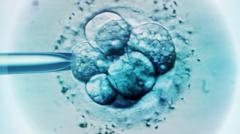In a remarkable medical achievement, a couple from Ohio, Lindsey and Tim Pierce, has welcomed a baby boy, Thaddeus Daniel Pierce, using an embryo that had been frozen for over 30 years. This event reportedly sets a new world record for the longest-frozen embryo to successfully result in a live birth. The Pierces shared that the experience felt surreal, with Lindsey describing it as "like something from a sci-fi movie."
The embryo, which was frozen in 1992, had previously remained unused for decades, while its original creator, Linda Archerd, 62, found herself navigating the intricate emotional landscape of embryo adoption. After undergoing In Vitro Fertilization (IVF) in 1994, Archerd had initially created four embryos; one developed into her now-30-year-old daughter, while three were left cryopreserved. Following her divorce, Archerd opted to keep those embryos, refusing to destroy them, donate to research, or place them anonymously with other families.
Through a Christian embryo adoption agency known as Nightlight Christian Adoptions—part of a program dubbed Snowflakes, which focuses on matching donors and prospective parents—Archerd was able to connect with the Pierces. With her specific preferences for a married Caucasian, Christian couple residing in the US, the match represented both hope and continuity for Archerd, as the baby would be biologically linked to her daughter.
The fertility clinic that facilitated the transfer, Rejoice Fertility in Tennessee, stated that their goal is to provide fertile ground for any embryo, regardless of how long it has been frozen. Though the Pierces did not initially set out to achieve a record, their primary aspiration was simply to expand their family after a seven-year journey through infertility and consideration of various paths to parenthood.
Ms. Archerd has not yet met her newborn grandson but is already drawn by the resemblance he bears to her daughter. This historical birth has sparked significant interest and conversation about embryo adoption, the complexities surrounding it, and the evolving face of parenthood in the USA.




















